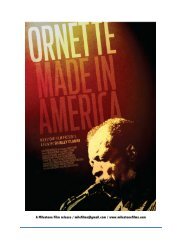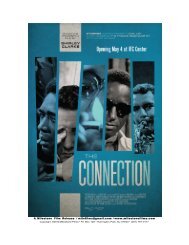ORNETTE Press Kit.8.7.2012 - Shirley Clarke
ORNETTE Press Kit.8.7.2012 - Shirley Clarke
ORNETTE Press Kit.8.7.2012 - Shirley Clarke
You also want an ePaper? Increase the reach of your titles
YUMPU automatically turns print PDFs into web optimized ePapers that Google loves.
A previously unpublished photo of a young <strong>Shirley</strong> <strong>Clarke</strong> dancing at the<br />
University of North Carolina. Courtesy of Wendy <strong>Clarke</strong>.<br />
However, by the early 1950s, with a young daughter and an aging body, <strong>Clarke</strong> decided<br />
to try filmmaking. The Brimberg family had always had a motion picture camera — there<br />
are home movies dating back to the early 1920s — and <strong>Shirley</strong> had received a 16mm<br />
camera as a wedding present.<br />
“Most of the dance films I’d seen were awful and I figured I could do better. Essentially,<br />
film’s a choreographic medium.” — Los Angeles Times interview, 1976<br />
<strong>Shirley</strong> <strong>Clarke</strong> started out with what she knew best — dance and movement — and she<br />
quickly became an esteemed filmmaker at a time when only a handful of women worked<br />
in the field. (There were Mary Ellen Bute, Maya Deren, Ida Lupino and Helen Levitt to<br />
name a few.) She studied filmmaking with Hans Richter at the City College of New York,<br />
and made her first film, an adaptation of Daniel Nagrin’s ballet Dance in the Sun, in 1953.<br />
The film featured fluid intercuts from interior and exterior locations and did not (as<br />
dance films traditionally had) cut between long shots and close–ups of the dancers,<br />
which <strong>Clarke</strong> believed broke up the original patterns of expression in the choreography.<br />
She believed that “dance as it existed on the stage had to be destroyed in order to have a<br />
good film and not just a rather poor document.” (From Gretchen Berg’s “Interview with<br />
<strong>Shirley</strong> <strong>Clarke</strong>,” Film Culture, no. 44, Spring 1967: 52.)<br />
<strong>Clarke</strong>’s conversations with fellow dancer and filmmaker Maya Deren encouraged her to<br />
further her progress. There was a love–hate relationship between the two women




